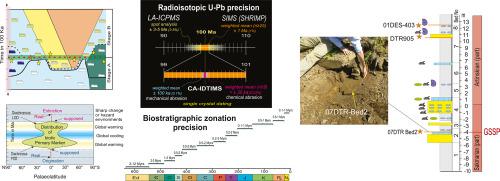当前位置:
X-MOL 学术
›
Gondwana Res.
›
论文详情
Our official English website, www.x-mol.net, welcomes your
feedback! (Note: you will need to create a separate account there.)
Shift in the paradigm for GSSP boundary definition
Gondwana Research ( IF 7.2 ) Pub Date : 2020-10-01 , DOI: 10.1016/j.gr.2020.06.005 V.I. Davydov
Gondwana Research ( IF 7.2 ) Pub Date : 2020-10-01 , DOI: 10.1016/j.gr.2020.06.005 V.I. Davydov

|
Abstract For over 200 years the use of biotic events as the basis for the establishment of chronostratigraphic boundaries has been the only approach successfully utilized for international and national chronostratigraphy. The traditional biostratigraphic method provides relatively high resolution, averaging 1 Ma or sometimes less. This biochronological evolutionary approach to the Global Boundary Stratotype section and Point (GSSP) utilizes biotic Primary Markers (PM), with a few exceptions, encompasses the integrated PM and other non-PM markers as the general principles for defining GSSP boundaries and is a reasonably reliable mechanism for global correlation and a relatively stable International Geologic Time Scale (IGTS). The biotic PM's, however, possessed several serious restrictions: the nature of biological taxonomy, climatic, sedimentary, environmental - and directly applicable within the tropics-subtropics only. Biotic evolution and radiogenic isotopes are the only systems in geologic time that encompass the direction of time. The latter possessed less restrictions than the former. The recent tendency to define GSSP's utilizing magnetic chrons, climatic events and geochemistry may work in the Cenozoic, but is useless in the Mesozoic and older sediments because their cyclic nature (repeatedness) and the need for a second, directional in time index (biostratigraphic or radioisotopic) to place the PM in the right position within the scale. I propose here to utilize volcanic ash beds as the best Primary Marker in geologic chronostratigraphy. The U-Pb system is one of the most dependable of the geochronologic systems because it relies on a simple and non-interpretive radioisotopic decay constant. The ash-bed GSSP as a lithological horizon is universal for the GSSP definition and can be correlated as an age in any facies (marine, lagoon and continental), regardless of paleoclimatic zones, paleoceanographic, geochemical, and most other geological factors. Even moderate level metamorphism (>900 °С) does not affect the U-Pb dating of zircons. The GSSP at the base of a volcanic ash bed (Primary Marker) could be established in a short working time and these ash beds can be integrated with the existing as well as new biostratigraphic, geochemical, magnetostratigraphic and astronomical data (Secondary Markers) to create a robust, accurate and highly useable time scale. Several potential GSSP's that could be established with the volcanic ash beds close to the traditional and/or historical boundaries serve as examples for this approach and include Devonian-Carboniferous, Moscovian-Kasimovian, Kasimovian-Gzhelian, and Sakmarian-Artinskian boundaries.
中文翻译:

GSSP 边界定义范式的转变
摘要 200 多年来,利用生物事件作为建立年代地层边界的基础一直是国际和国内年代地层学成功利用的唯一方法。传统的生物地层方法提供相对较高的分辨率,平均为 1 Ma 或有时更低。这种全球边界层型部分和点 (GSSP) 的生物年代进化方法利用生物初级标记 (PM),除了少数例外,包括综合 PM 和其他非 PM 标记作为定义 GSSP 边界的一般原则,并且是合理的全球相关性的可靠机制和相对稳定的国际地质时标(IGTS)。然而,生物 PM 具有几个严重的限制:生物分类学的性质、气候、沉积的、环境的 - 并且仅直接适用于热带 - 亚热带地区。生物进化和放射性同位素是地质时间中唯一包含时间方向的系统。后者的限制比前者少。最近利用磁年代、气候事件和地球化学来定义 GSSP 的趋势可能适用于新生代,但在中生代和更古老的沉积物中无用,因为它们的循环性质(重复性)和需要第二个定向时间指数(生物地层或放射性同位素)将 PM 放置在刻度内的正确位置。我在这里建议利用火山灰层作为地质年代地层学的最佳主要标志。U-Pb 系统是最可靠的地质年代系统之一,因为它依赖于简单且非解释性的放射性同位素衰变常数。灰层 GSSP 作为岩性层位对于 GSSP 定义是通用的,并且可以与任何相(海洋、泻湖和大陆)的年龄相关联,而不管古气候带、古海洋、地球化学和大多数其他地质因素。即使是中等程度的变质作用(>900 °С)也不影响锆石的 U-Pb 定年。火山灰层底部的 GSSP(一级标记)可以在短时间内建立,这些火山灰层可以与现有的以及新的生物地层、地球化学、磁地层和天文数据(二级标记)相结合,创建一个健壮、准确和高度可用的时间尺度。
更新日期:2020-10-01
中文翻译:

GSSP 边界定义范式的转变
摘要 200 多年来,利用生物事件作为建立年代地层边界的基础一直是国际和国内年代地层学成功利用的唯一方法。传统的生物地层方法提供相对较高的分辨率,平均为 1 Ma 或有时更低。这种全球边界层型部分和点 (GSSP) 的生物年代进化方法利用生物初级标记 (PM),除了少数例外,包括综合 PM 和其他非 PM 标记作为定义 GSSP 边界的一般原则,并且是合理的全球相关性的可靠机制和相对稳定的国际地质时标(IGTS)。然而,生物 PM 具有几个严重的限制:生物分类学的性质、气候、沉积的、环境的 - 并且仅直接适用于热带 - 亚热带地区。生物进化和放射性同位素是地质时间中唯一包含时间方向的系统。后者的限制比前者少。最近利用磁年代、气候事件和地球化学来定义 GSSP 的趋势可能适用于新生代,但在中生代和更古老的沉积物中无用,因为它们的循环性质(重复性)和需要第二个定向时间指数(生物地层或放射性同位素)将 PM 放置在刻度内的正确位置。我在这里建议利用火山灰层作为地质年代地层学的最佳主要标志。U-Pb 系统是最可靠的地质年代系统之一,因为它依赖于简单且非解释性的放射性同位素衰变常数。灰层 GSSP 作为岩性层位对于 GSSP 定义是通用的,并且可以与任何相(海洋、泻湖和大陆)的年龄相关联,而不管古气候带、古海洋、地球化学和大多数其他地质因素。即使是中等程度的变质作用(>900 °С)也不影响锆石的 U-Pb 定年。火山灰层底部的 GSSP(一级标记)可以在短时间内建立,这些火山灰层可以与现有的以及新的生物地层、地球化学、磁地层和天文数据(二级标记)相结合,创建一个健壮、准确和高度可用的时间尺度。









































 京公网安备 11010802027423号
京公网安备 11010802027423号